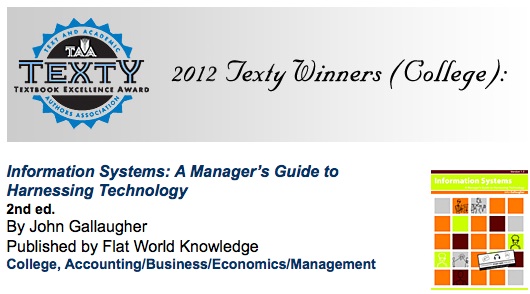
The Week in Geek™ – March 30, 2012
Fun fact: “There are more lines of code in a Ford car than in Twitter and Facebook combined“
Inside Facebook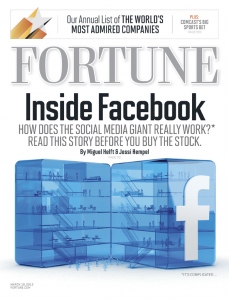 Our students have had the good fortune to visit Facebook’s new Menlo Park campus twice this year, and now Fortune offers a peek for everyone else in their cover story, “Inside Facebook”. Facebook’s new headquarters are the former Sun Microsystems digs (earlier TechTrek courses had been to this location several times for master-classes with then Sun boss, Scott McNealy).
Our students have had the good fortune to visit Facebook’s new Menlo Park campus twice this year, and now Fortune offers a peek for everyone else in their cover story, “Inside Facebook”. Facebook’s new headquarters are the former Sun Microsystems digs (earlier TechTrek courses had been to this location several times for master-classes with then Sun boss, Scott McNealy).
Facebook currently has 2,000 of 3,200 total employees at the new HQ, but the campus can hold (and will almost certainly eventually staff) about 10,000. 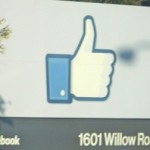 The road around Facebook’s new campus is named “Hacker Way”, concrete letters are being poured into a central courtyard, spelling the word “HACK” (BC trivia – a former student & his family construction biz is doing this work). There are two free-food cafeterias (a few of these are former Google gourmets), and the campus sports a bar called “The Shady Lady”. Graffiti-laden walls underscore that Facebook is a creative and edgy place, and slogans like “Done is Better than Perfect” and “Move Fast, Break Things” are cultural signposts that direct staff to keep an eye on what has helped make the firm successful. This is, after all, a business built on network effects, and in Facebook’s world, it’s either be quick or be dead. Side note: in 2005, Facebook’s graffiti artist took equity for payment and stands to make $200 million at IPO.
The road around Facebook’s new campus is named “Hacker Way”, concrete letters are being poured into a central courtyard, spelling the word “HACK” (BC trivia – a former student & his family construction biz is doing this work). There are two free-food cafeterias (a few of these are former Google gourmets), and the campus sports a bar called “The Shady Lady”. Graffiti-laden walls underscore that Facebook is a creative and edgy place, and slogans like “Done is Better than Perfect” and “Move Fast, Break Things” are cultural signposts that direct staff to keep an eye on what has helped make the firm successful. This is, after all, a business built on network effects, and in Facebook’s world, it’s either be quick or be dead. Side note: in 2005, Facebook’s graffiti artist took equity for payment and stands to make $200 million at IPO.
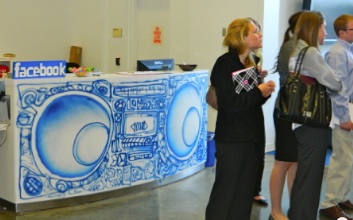 Coding at Facebook can be an exhilarating white-knuckle ride. Says one engineer, “it’s terrifying to ship code to Facebook and realize that there are a billion people out there using the service.” Engineers can be “geek vampires” participating in occasionally mandated all-nighters. At Facebook, “code wins arguments” and dissent is encouraged. Facebooker’s regularly claim that Zuck is happy to be proven wrong, but Zuckerberg-thinking is also at the center of the firm’s future. Facebook holds boot camps to teach staff to “Think like Zuck”. Every new employee also takes the Clifton StrengthsFinder test to uncover hidden talents. To keep the creativity flowing, staff are often forced to switch projects midstream. Every 18 months employees are required to leave their teams and work on something different for at least a month. Getting people into new groups helps the firm’s geniuses more broadly share their knowledge, generates idea-flow, and prevents managers from developing fiefdoms. The firm also runs legendary hackathons, all night sessions with one key rule: no one is allowed to work on what they normally do. Engineers blue-sky innovate on something new and show it to Zuckerberg and a senior staff brain trust, who then decide which projects go forward. Zuck also holds hour-long chats each Friday, engaging in deep Q&A with staff. The anti-social loaner depicted in “The Social Network” is, in fact,
Coding at Facebook can be an exhilarating white-knuckle ride. Says one engineer, “it’s terrifying to ship code to Facebook and realize that there are a billion people out there using the service.” Engineers can be “geek vampires” participating in occasionally mandated all-nighters. At Facebook, “code wins arguments” and dissent is encouraged. Facebooker’s regularly claim that Zuck is happy to be proven wrong, but Zuckerberg-thinking is also at the center of the firm’s future. Facebook holds boot camps to teach staff to “Think like Zuck”. Every new employee also takes the Clifton StrengthsFinder test to uncover hidden talents. To keep the creativity flowing, staff are often forced to switch projects midstream. Every 18 months employees are required to leave their teams and work on something different for at least a month. Getting people into new groups helps the firm’s geniuses more broadly share their knowledge, generates idea-flow, and prevents managers from developing fiefdoms. The firm also runs legendary hackathons, all night sessions with one key rule: no one is allowed to work on what they normally do. Engineers blue-sky innovate on something new and show it to Zuckerberg and a senior staff brain trust, who then decide which projects go forward. Zuck also holds hour-long chats each Friday, engaging in deep Q&A with staff. The anti-social loaner depicted in “The Social Network” is, in fact, 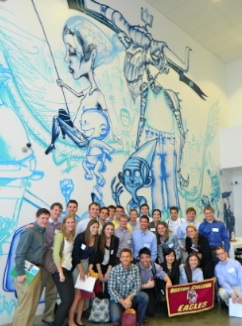 radically different from the real guy who’s piloting the tech industry’s biggest IPO ever. Faculty, be nice to your brightest students. Zuck’s former Harvard TA is now a Director of Engineering and stands to clean up when the firm goes public. Of course, for Zuckerberg it’s never been about the coin. The firm’s mantra is “we don’t build services to make money, we make money to build services.”
radically different from the real guy who’s piloting the tech industry’s biggest IPO ever. Faculty, be nice to your brightest students. Zuck’s former Harvard TA is now a Director of Engineering and stands to clean up when the firm goes public. Of course, for Zuckerberg it’s never been about the coin. The firm’s mantra is “we don’t build services to make money, we make money to build services.”
Zuck’s business-side foil is Sheryl Sandberg, the firm’s Chief Operating Officer, soon-to-be billionaire, and one of the most powerful women in business. Sandberg, who built Google’s ad biz before being wooed by Zuckerberg, is also co-chair of the “ultra-powerful meetup”, the Davos World Economic Forum, she has become a leading spokesperson for a “new generation of women in the workplace” (her powerful TED Talk on ‘why we have too few women leaders’ is a must watch) and she is often thought to have deeper, post-Facebook, political ambitions (her pre-Google career included time as Chief of Staff of the U.S. Dept. of Treasury under Larry Summers). And tech is all in her family – husband David Goldberg is CEO of SurveyMonkey. Fortune credits Sandberg with creating the business-focus that drove Facebook to $1 billion in pre-IPO profits, and in fostering much-needed staff stability. The piece notes that while Google lost virtually none of its senior staff until after its IPO, Facebook lost one president, two CFOs, a COO, and all of Zuckerberg’s cofounders. Facebook senior management style under Sandberg is described as having “more coaches than bosses, more facilitators than gatekeepers.” Fortune also profiled Facebook’s CFO David Ebersman, who has a pretty amazing bag of tricks. He was Genentech’s head of product development, he ran the biotech giant’s manufacturing, and he was CFO during the acquisition of the world’s largest biotech firm by Roche (he also worked under Genentech CEO Art Levinson, who himself has been a board member at both Apple and Google).
Commentary: Two tech firms with radically different corporate cultures and wildly successful recent histories are within a short drive of one-another: Apple and Facebook. Infinite Loop is perfectionist and secretive. Hacker Way is free-wheeling and open. Management strategists will spend years picking apart these highly successful and divergent innovation models, hoping to figure out which one ‘works best,’ and under what conditions. Here are some thoughts: Apple’s hardware products can’t fail at launch. Massive hardware ‘fixes’ typically can’t be pushed out through ‘the cloud’, so the firm must be perfect. But Facebook can hit a reset & make any updates instantly available to its entire user-base (or a testable sub-set). Facebook’s speed-focus is understandable. Theirs is a space others could have won but lost because they were slow with features (‘true’ user identity, feeds, an open apps platform, ‘like’, the open graph). As a result, users flocked to Zuck, tipping the bulwark, winner-take-all, strategic assets of network effects and switching costs to craft a Goliath now used by one in eight of the planet’s citizens (and remember, China-blocked Facebook isn’t even allowed in the world’s biggest nation). MySpace, Friendster, what you could have been had you paid attention and had a bit of hacker ethic at the top! This is a pattern we’ve seen before when Google blew past Yahoo! Weaker thinking interprets this as there being no first mover advantage but that’s not it at all. Instead the early movers FAILED to match superior products that they COULD have copied. Facebook and Google aren’t houses built on patents (despite Yahoo’s recent claims) – instead these new rivals had a time lead on better, unmatched efforts that created durable advantages that currently seem insurmountable.
The innovation/culture question will be fascinating to watch. Fortune asks, “Can Facebook keep this edge, or will it get soft with the relentless pressure of quarterly earnings, sheer size, sudden wealth, and mounting legal concerns as it becomes a big, rich target for everything from patent litigation to zealous lawmakers and privacy advocates.” Stay tuned for the status update!
Twitter: The Startup That Wouldn’t Die: Now that Facebook is going public, Silicon Valley job-hoppers seeking an IPO payday are orbiting Twitter. About 10% of the firm’s 900 employees are former Googlers. Twitter’s prospects are looking good, as it tries to grow into the $8 billion valuation pegged following the past summer’s investment by “Russian moneybags” DST. A host of new ad products has attracted A-list advertisers and has the firm on pace to earn $260 million in 2012.
Now that Facebook is going public, Silicon Valley job-hoppers seeking an IPO payday are orbiting Twitter. About 10% of the firm’s 900 employees are former Googlers. Twitter’s prospects are looking good, as it tries to grow into the $8 billion valuation pegged following the past summer’s investment by “Russian moneybags” DST. A host of new ad products has attracted A-list advertisers and has the firm on pace to earn $260 million in 2012.
Twitter hashtags (keywords following the ‘#’ classification symbol) are now becoming a key part of the marketer playbook, right up there with URLs, Facebook ‘Like’, and SEO/SEM. The White House released a transcript of the most recent State of the Union speech full of hashtag annotation. And this year’s Super Bowl television ads boasted hastags in eight of the 42 commercials (last year only Audi showed a hashtag).
Like many social media services, corporations can contribute content along with other users, free of charge. That creates a bit of a ‘free rider’ problem, where firms benefit from a platform without directly paying for the resources they use. But corporate use can make Twitter more valuable to users who opt-in to ‘follow’ brands in their Twitter feed. And Twitter-hooked advertisers can pay to more prominently feature their messages. “Promoted Tweets” are ads that appear on top of the user’s feed. Advertisers pay only when a user “engages” the tweet by retweeting or clicking a link. Like Google’s AdWords, Promoted Tweet appearance is performance-driven – the more clicks an ad receives the more it’ll show up. Engagement stats are strong – averaging 3% to 5% vs. less than 0.5 percent for banner ads. Promoted Tweets appear in the browser as well as desktop clients like Twitter-owned TweetDeck, and they’re rolling out on mobile devices, as well (pushing Twitter ahead of Facebook with a mobile advertising product). Political ads have come to Twitter, too. As part of the Feb. GOP debate in Arizona, Gingrich campaign bought a promoted tweet with a link to a petition that occurred any time a user searched for either “Newt Gingrich” or “Mitt Romney.” A Gingrich consultant says the Twitter ads are “the best rapid-response tool that exists in politics right now.”
There are also “Promoted Trends” that appear on trending topics lists (avg. cost for a US run? About $120,000 for a day). Use example: Disney bought a Promoted Trend as part of the Toy Story 3 premiere. Twitter also sells “Promoted Accounts” to anyone that wants their Twitter handle featured as a recommendation to for users to follow (a move advertisers can use to announce they’re on Twitter & potentially pump up their follower count).
Advertisers are still learning the ins and outs of the Twitter free-for-all. Among the tips you’ll find in the social media slides I share with my class, Twitter works well for: real-time promotions, time-sensitive information, firms with ‘enthusiast’ customers, and firms that can and should have a conversation online. It can be important to think through how a campaign might be received by everyone online. A January attempt by McDonalds to encourage users to share #McDStories saw the hashtag raided by critics and pranksters tweeting about “food poisoning, weight gain, and poor employee hygiene.” Yikes!
Twitter lacks the kind of accurate profile information of a Facebook, which often knows your name, gender, relationship status, musical tastes, and more. But Twitter’s CEO describes the firm as targeting the “interest graph – the set of characteristics that can be gleaned from users’ followers and what they click on. “ Twitter is much smaller than Facebook (100 million active users vs. 840 million on Facebook), but BusinessWeek quips that Twitter has “become the pulse of a planet-wide news organism, hosting the dialogue about everything from the Arab Spring to celebrity deaths.” Use has shot up following tighter integration with Apple’s iOS, and links with Macs are on the way with the recently announced “Mountain Lion” OS X upgrade (Twitter CFO is Ali Rowghani, who was previously CFO for the late Steve Jobs at Pixar). Twitter CEO has also received coaching from former BC Football Coach, Apple board member & Intuit Chair, Bill Campbell. Another BC connection? The firm received funding from Spark Capital’s Bijan Sabet, a Boston College alum!
Seeing Red – Vanity Fair Profile of Netflix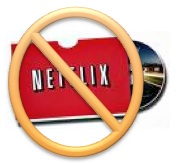 The second half of 2011 was costly for Netflix. Vanity Fair calls the split of a unified product into higher-priced DVD and streaming products and the subsequent Qwikster debacle “one of the worst self-inflicted corporate disasters in recent memory”, a series of events that wiped out over $12 billion in firm value. Netflix CEO Reed Hastings saw his salary cut by $1.5 million and has been contrite, admitting that he “slid into arrogance.” The firm also recently raised $400 million in cash, $200 million in a secondary offering at $70 a share, and $200 million from longtime investor TCV. Doubtless it’d have been nicer for Hastings to have done this a few months earlier when the firm’s stock price was a nosebleed-high $300+.
The second half of 2011 was costly for Netflix. Vanity Fair calls the split of a unified product into higher-priced DVD and streaming products and the subsequent Qwikster debacle “one of the worst self-inflicted corporate disasters in recent memory”, a series of events that wiped out over $12 billion in firm value. Netflix CEO Reed Hastings saw his salary cut by $1.5 million and has been contrite, admitting that he “slid into arrogance.” The firm also recently raised $400 million in cash, $200 million in a secondary offering at $70 a share, and $200 million from longtime investor TCV. Doubtless it’d have been nicer for Hastings to have done this a few months earlier when the firm’s stock price was a nosebleed-high $300+.
But with all the outrage and ridicule (did you see the SNL apology parody and another featuring a bogus Hastings with Zuck and Arianna Huffington?), Netflix remains a darling of the movie studios because it is a paying distribution channel that can milk the otherwise idle asset of a firm’s back-catalog of films. CBS CEO Les Moonves, says Hastings and Netflix Chief Content Officer Ted Sarandos “are two of the smartest people in the industry”. “We welcomed Netflix into the marketplace… they’re paying us in a brand-new way that opens up many horizons for the future.” CBS might even start producing original content that appears first on Netflix. The CEO of Viacom, Philippe Dauman, says They continue to be a good partner for us… When you have the resources they have and the reach that they have—we’re all looking for new revenue streams—they’re the newest and most exciting, and biggest.” Ron Meyer, the head of Universal Studios, says “On a scale of 1 to 10, they’re a 10.”
Critics also gripe that Netflix is propping up profitability with “accounting gimmicks” that more slowly amortize the cost of streaming licensing, while doubling its account payable period. But Netflix has fired back against these arguments and posted the best comeback of all, a better-than-expected Q4 2011 in which it announced a profit of $52 million and over 220,000 new streaming-only customers.
The next year will be tough. As detailed in a chart in the Netflix Chapter of my book, the streaming business has vastly different economics and competitive dynamics than subscription discs via mail. Amazon, Hulu, and Blockbuster (through its parent Dish Network) have all launched Web video subscription services, but none has created what can be considered a credible rival, offering the selection and price of Hastings’ offering. AllThingsD says that even Comcast Streampix, called a ‘Netflix Killer” by some, isn’t. Comcast execs refuse to offer the streaming service outside the firm’s customer base, claiming they can’t profitably do it for $8 a month and can’t understand how Netflix can, either.
How Target Figured Out A Teen Girl Was Pregnant Before Her Father Did A data-mining expert from the retail giant Target told a New York Times reporter “Just wait. We’ll be sending you coupons for things you want before you even know you want them.” No waiting required, it seems the firm has found a way to “data mine its way into the womb”.
A data-mining expert from the retail giant Target told a New York Times reporter “Just wait. We’ll be sending you coupons for things you want before you even know you want them.” No waiting required, it seems the firm has found a way to “data mine its way into the womb”.
It turns out, an irate father recently stormed into a Minnesota Target, demanding to see the store manager, and clutching coupons that had been sent to his daughter. The coupons contained ads for maternity clothing, nursery furniture and pictures of smiling babies. “My daughter got this in the mail!” said the dad, “She’s still in high school, and you’re sending her coupons for baby clothes and cribs? Are you trying to encourage her to get pregnant?” The manager apologized and phoned a few days later to reiterate. But by then the father had a bit of his own intelligence that, it appears, Target was able to glean in advance from analyzing purchasing habits. Said dad, “I had a talk with my daughter. It turns out there’s been some activities in my house I haven’t been completely aware of. She’s due in August. I owe you an apology.”
How did Target know? It turns out that some habits can be gleaned from women on the baby registry that also apply to those who haven’t signed up: for example, moms-to-be load up on unscented lotion at the beginning of their second trimester. Another data run showed that about 20 weeks into their pregnancy, women up their vitamin supplements. A switch to scent-free soap and extra-big bags of cotton balls is another sign there’s likely a little-one on the way.
Those engaged in ‘predictive analytics’ are keen to pay attention to pregnancy because, as one researcher put it, there are “brief periods in a person’s life when old routines fall apart and buying habits are suddenly in flux.” During these times (and pregnancy and the arrival of a new baby is one of them) “shopping patterns and brand loyalties are up for grabs.” Opt-in registry signup may be later than some firms want to wait. Says one marketer “if we could identify them in their second trimester, there’s a good chance we could capture them for years.” But step over the unclear line where a firm shows that it has learned a bit too much about customers, and you get a major privacy creep-out.
Target tends to be conservative in complying with privacy laws, but they also realize they need to back off to avoid the creep-out factor. Says one exec “we learned that some women react badly. Then we started mixing in all these ads for things we knew pregnant women would never buy, so the baby ads looked random. We’d put an ad for a lawn mower next to diapers. We’d put a coupon for wineglasses next to infant clothes. That way, it looked like all the products were chosen by chance… We found out that as long as a pregnant woman thinks she hasn’t been spied on, she’ll use the coupons. She just assumes that everyone else on her block got the same mailer for diapers and cribs. As long as we don’t spook her, it works.”
The Times piece reveals that Target tries to assign customers a unique “Guest ID number,” and links this to things like credit card use, trackable coupons, surveys, mail-in refunds, phone calls to the firm’s help line, web use, and e-mail promotion response. Demographic info is also linked to the Guest ID: age, marital status, whether or not you have kids, which part of town you live in, distance from the store, estimated income, whether you’ve moved, credit cards used, and some web information. And while the Times didn’t confirm that Target looks at this, there are third-party databases that can be purchased and linked to existing customer information, including: ethnicity, job history, magazine subscriptions, catalog buying history, financial history (bankruptcy, home purchase and foreclosure), college, brand preference, political leanings, charitable giving, auto ownership, and more. Yup – you’re for sale and there’s big bucks in building a targetable, digital-you! Math geeks interested in working as data-miners are in huge demand. Says a former Amazon Chief Scientist: “Mathematicians are suddenly sexy.”
The longer New York Times piece about the events above, titled “How Companies Learn Your Secrets”, is a highly-recommended read for faculty teaching data mining, and great discussion fodder for class conversations on possibilities, ethics, best practices, and the implications of technology use.
◆ ◆ ◆
And a quick thanks to all who continue to support my Textbook project. The book “Information Systems: A Manager’s Guide to Harnessing Technology” has won a 2012 “Textbook Excellence Award” (known as the “Texty”) from the Text and Academic Authors Association. My publisher, Flat World Knowledge, my students, and all of the adopting faculty and friends of the project have been wonderfully helpful in the book’s continued and sustained impact on our field. thanks so much for your support and for sharing information about the project with others!

